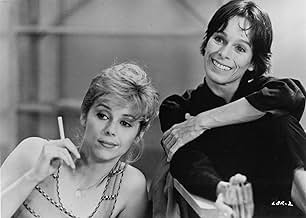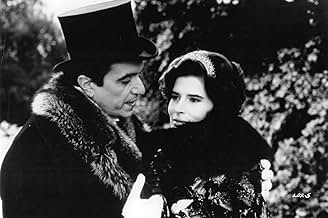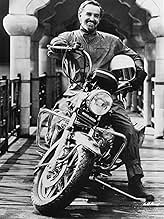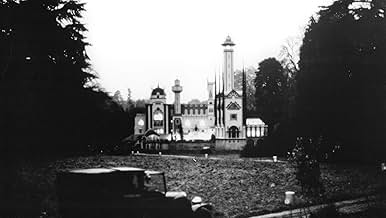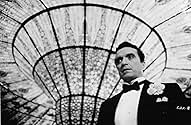La vie est un roman
- 1983
- Tous publics
- 1h 50min
NOTE IMDb
6,1/10
1,3 k
MA NOTE
En 1919, trois jeunes gens passent leurs vacances dans le château d'un ami. Tous les quatre seront les protagonistes de plusieurs histoires qui finiront inévitablement par s'entremêler.En 1919, trois jeunes gens passent leurs vacances dans le château d'un ami. Tous les quatre seront les protagonistes de plusieurs histoires qui finiront inévitablement par s'entremêler.En 1919, trois jeunes gens passent leurs vacances dans le château d'un ami. Tous les quatre seront les protagonistes de plusieurs histoires qui finiront inévitablement par s'entremêler.
- Réalisation
- Scénario
- Casting principal
- Récompenses
- 3 nominations au total
Avis à la une
Having seen this film only once, in 1983 during its initial NYC engagement, I can resonantly advise anyone lucky enough to get the chance: prepare for elegant effervescence. The score by itself is unforgettable -- giddy, but it'll haunt you.
First off, the commonly accepted translation of the title seems to be bad-It should more properly be called Life is a Fairy Tale. This film explores two main themes. The first theme involves the idea that people never really grow up-they continue to be self centered children with unrealistic views of the world. The other theme is that no individual can be happy unless some other individual is miserable. These themes are explored in typical Resnais fashion-which is to say, in a way that is in turns brilliant and confusing. Naturally, the narrative is not straightforward, rather, it is broken into two main threads and a third crucial but brief one.
The most bizarre (and off putting) thing about this film is the singing-occasionally, a character will suddenly begin singing instead of talking. The other characters tend to respond with normal dialogue as if nothing unusual was going on. This lends a sort of surreal feeling to the already odd mood of the film. According to the special features of the DVD of this, Resnais feels that it is easier to move the story along if his characters sing instead of conversing.
I've only seen this film once, but I feel that I should see it again soon. Resnais films always reward multiple viewings and I doubt this is the exception.
The most bizarre (and off putting) thing about this film is the singing-occasionally, a character will suddenly begin singing instead of talking. The other characters tend to respond with normal dialogue as if nothing unusual was going on. This lends a sort of surreal feeling to the already odd mood of the film. According to the special features of the DVD of this, Resnais feels that it is easier to move the story along if his characters sing instead of conversing.
I've only seen this film once, but I feel that I should see it again soon. Resnais films always reward multiple viewings and I doubt this is the exception.
Watching the first few moments, you realize it's going to be a parody - and certainly it *is* a parody, but I'm not sure of what (a fairy tale? an opera? a Hollywoodian C-movie? - if there was something like that), and I can assure you it's not worth watching. It's simply a pointless film (cf. a good parody is everything but pointless), with pretentious, shallow speeches of extremely sketchy characters. It's like a commedia dell'arte. Or better, it's like a botched commedia dell'arte. And the score... sung in an intentionally incompetent way (something Greenaway will use much more efficiently), it *is* painful to listen to (unless one wears some sate-of-the-art earplugs, haha). Go for quality movies (e.g. A. Mitta's How Czar Peter the Great Married Off His Moor, 1976) and steer clear of this mistake.
Resnais explores the concept of Utopia in three, intermingled timelines in this musical comedy. Actually, the film is so confusingly told that I had to read up on it a little before understanding it. Generally, though, it's a pretty enjoyable little film. In the modern timeline, a group of educators gathers at a castle at a symposium for alternative education. Geraldine Chaplin makes a bet that she can get the shy Sabine Azema to fall in love with Pierre Arditi. Vittorio Gassman also co-stars in this timeline. Another plot line follows the builder of that castle (Ruggero Raimondi) as he attempts to create a Utopian society after WWI. Fanny Ardant co-stars in that timeline. The third section is kind of an operatic fantasy. The production design is really neat, but I was at a loss as to what was going on there until very near the end of the film, where it became a bit clearer. The film is occasionally a musical, and the music is pretty decent.
The film is outrageously surreal and amazing: 'Life is a Bed of Roses' opens in cinematic photography that flows in a beautiful image of an autumnal season with gentlemen in black cloaks and top hats, and with women in colourful ball gowns who converge in a flock on a green lawn within a forest.
The film engages interest from the very beginning with the cluster of characters, focusing our attention and intriguing us with striking and interesting dialogue - there are lots are ideas swirling around here. There is humour too -tending to be macabre, but intended to be childish as well.
And so, the film begins in the grounds of a forest in Arden where a strange castle is to be built by an eccentric and wealthy Count. The invited special guests 'coo' together in chorus of astonishment as the model of the fairy tale castle is revealed. The castle is decorated in a mixture of colours with imagination to the exotic and the orient -the design and the colours are inspiring to the imagination:
The story will revolve around the castle in 3 stories of different time zones, but not involving the same characters. Ingeniously, the film moves effortlessly and mysteriously in each time zone. It is like a story within a story, and there seems to be no boundary of time.....from an ancient kingdom that intrigues - like a Shakespearian play that is set in extraordinary colours in the forest.....to a present day that is set 60 years after the castle was built ( with a fleeting and a dreamy reference to WW1, which interrupted the full completion of the castle ).....and then of course back to the first part of the story with the original guests who viewed the model castle and are back again once the castle was completed.....
There is strange music which is significant to enhance the oddness of the story, and outbreaks of singing, which accords to the style of the filming....
To simplify and reveal some of the plot details: The castle was built as a temple to accommodate the guests to live with the Count and be part of an experiment by drinking a potion that will fulfil a rebirth to bring harmony and happiness....
The present day setting of the castle is used as a private and illusive school to educate children in a new wave of development: The Holberg method. Look out for Geraldine Chaplin as she arrives with her daughter in a car that breaks down in the forest leading up to the castle. It is the Forest of Arden as Geraldine gives reference to Shakespeare as she walks off to walk to the castle, and replies to her daughter, 'As You Like It' as her child then joins 3 other children who are playing in the in forest. There are very funny and engaging scenes with the children throughout the film....
Following in the present day, the castle has been reserved to hold a conference for visiting teachers who engage together on The Holberg project of education- the lady teachers speculate on aspects of love, but misjudge the outcome....
The general theme of the film speculates on whether love is a remedy for harmony and happiness - and if a rebirth of the heart of love can materialize into this genre of peace - and can the world be a better place to live without a leader?
There are indeed threads of ideas that fuse all 3 stories together: it is a collage of ideas mixed together with visual art that delights in surreal imagination. The film is directed by Alain Resnais, and is in tribute to 3 other French film makers -Geroges Melies, Marcel L'Herbier, and Eric Rohmer: hence 3 tales absorbingly connected in fascination and mystique.
I guess that if you are going to like the film, you either have to be slightly mad, or be like Salvador Dali? I love the film -it is timeless! I think it is truly a masterpiece of film making - it is astonishing and very interesting. I feel rewarded and refreshed as though I had participated in the film myself!
Also starring Fanny Ardant.... .
The film engages interest from the very beginning with the cluster of characters, focusing our attention and intriguing us with striking and interesting dialogue - there are lots are ideas swirling around here. There is humour too -tending to be macabre, but intended to be childish as well.
And so, the film begins in the grounds of a forest in Arden where a strange castle is to be built by an eccentric and wealthy Count. The invited special guests 'coo' together in chorus of astonishment as the model of the fairy tale castle is revealed. The castle is decorated in a mixture of colours with imagination to the exotic and the orient -the design and the colours are inspiring to the imagination:
The story will revolve around the castle in 3 stories of different time zones, but not involving the same characters. Ingeniously, the film moves effortlessly and mysteriously in each time zone. It is like a story within a story, and there seems to be no boundary of time.....from an ancient kingdom that intrigues - like a Shakespearian play that is set in extraordinary colours in the forest.....to a present day that is set 60 years after the castle was built ( with a fleeting and a dreamy reference to WW1, which interrupted the full completion of the castle ).....and then of course back to the first part of the story with the original guests who viewed the model castle and are back again once the castle was completed.....
There is strange music which is significant to enhance the oddness of the story, and outbreaks of singing, which accords to the style of the filming....
To simplify and reveal some of the plot details: The castle was built as a temple to accommodate the guests to live with the Count and be part of an experiment by drinking a potion that will fulfil a rebirth to bring harmony and happiness....
The present day setting of the castle is used as a private and illusive school to educate children in a new wave of development: The Holberg method. Look out for Geraldine Chaplin as she arrives with her daughter in a car that breaks down in the forest leading up to the castle. It is the Forest of Arden as Geraldine gives reference to Shakespeare as she walks off to walk to the castle, and replies to her daughter, 'As You Like It' as her child then joins 3 other children who are playing in the in forest. There are very funny and engaging scenes with the children throughout the film....
Following in the present day, the castle has been reserved to hold a conference for visiting teachers who engage together on The Holberg project of education- the lady teachers speculate on aspects of love, but misjudge the outcome....
The general theme of the film speculates on whether love is a remedy for harmony and happiness - and if a rebirth of the heart of love can materialize into this genre of peace - and can the world be a better place to live without a leader?
There are indeed threads of ideas that fuse all 3 stories together: it is a collage of ideas mixed together with visual art that delights in surreal imagination. The film is directed by Alain Resnais, and is in tribute to 3 other French film makers -Geroges Melies, Marcel L'Herbier, and Eric Rohmer: hence 3 tales absorbingly connected in fascination and mystique.
I guess that if you are going to like the film, you either have to be slightly mad, or be like Salvador Dali? I love the film -it is timeless! I think it is truly a masterpiece of film making - it is astonishing and very interesting. I feel rewarded and refreshed as though I had participated in the film myself!
Also starring Fanny Ardant.... .
Le saviez-vous
- AnecdotesWhile old fashioned Kodak film was used for the 1910s scenes and legendary period, modern Fuji film was shot for the 1982 storyline, opposing dreamlike effects of the former to realism of the latter.
- ConnexionsFeatured in Legendy mirovogo kino: Fanny Ardant
Meilleurs choix
Connectez-vous pour évaluer et suivre la liste de favoris afin de recevoir des recommandations personnalisées
- How long is Life Is a Bed of Roses?Alimenté par Alexa
Détails
- Durée
- 1h 50min(110 min)
- Mixage
- Rapport de forme
- 1.66 : 1
Contribuer à cette page
Suggérer une modification ou ajouter du contenu manquant

